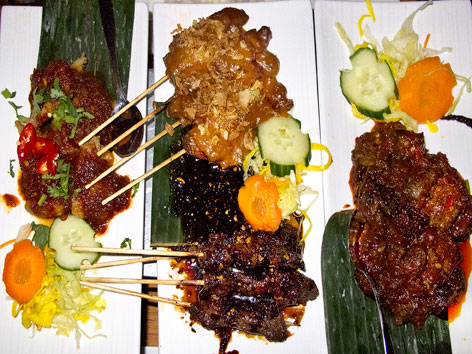Ethiopian Chicken Stew (Doro Wett)
Ethiopia
amantour
guides you to the best local dishes & drinks in
125+ cities. See map now



Kindle now on Amazon.com!
Download our new Amsterdam Food & Travel Guide to your Kindle, smartphone, or tablet and get the inside scoop on the best Dutch foods in Amsterdam, plus a bonus restaurant guide and 5-day EYW itinerary. $3.99
EYW wants your food photos!

EYW wants your food stories!
Hey guys I am a traveler who loves to explore different places around the world. I often visit outside of Canada, So whenever I have to travel around the world I always book my flight tickets from the... Read more

What: Dutch for “rice table,” rijsttafel (“ryst-tah-fell”) is a by-product of Dutch colonialism in Indonesia, which, if we count the days of the Dutch East India Company, stretched for more than three centuries, formally concluding in 1949. When the Dutch returned home, they brought with them an undying affection for satay (spicy peanut) sauce; a handful of Indonesian stir-fry standards; and this practice of serving many small Indonesian dishes, revolving around rice, at once to best show off the archipelago’s flavorful cuisine (it’s likely the Dutch were inspired by a similar Sumatran manner of feasting, called nasi padang). Modern-day rijsttafel is the same exact idea: Cram every inch of your table with anywhere from eight to 40 small plates—a variety of meats, vegetables, and condiments, like sambals and pickled dishes—and eat them with steamed white rice. It’s a tradition that is relatively unique to the Netherlands today, where it’s considered nearly as indigenous as stamppot, and it adds some much-appreciated exotic spiciness to Amsterdam’s culinary scene. If you crave a change from those hearty Dutch classics you’ve been filling up on, rijsttafel is your answer. Just show up hungry.
Where: Amsterdam has many good rijsttafel options, and some of the better ones get very expensive, fast. We chose Sampurna (Singel 498) based not only on its (mostly) favorable reviews, but also its various price points (four options ranging from €27,50 to €34,50) and reputation for being one of the spicier Indonesian restaurants in town. Bonus: It’s located across from the Bloemenmarkt (flower market), which will be open if you come at lunch.
When: Daily, noon-10:30pm
Order: We ordered a few “celebes” (€34,50 per person, 15 dishes)—the “highest quality,” according to our server—and vegetarian (€27,50, 12 dishes) rijsttafels, which were served family-style in a long row across our table. Don’t be fooled thinking you need 40 dishes—15 proved more than sufficient! (And we, uh, like to eat.) Favorites among the spread were the very spicy daging blado (tender braised beef), sate lilit (grilled minced fish on a lemongrass skewer, with peanut and spicy chile sauce), sate kambing (skewered goat with a complex, richly flavorful sauce), and, off the veg menu, tahu pepes (tofu with fresh lemon basil, in a banana leaf). Pictured is the braised beef, the goat and chicken (ayam) satays, and the fish in spicy Balinese sauce (ikan Bali). To drink? Indonesia’s Bir Bintang—brewed by a Heineken subsidiary, fittingly.
Alternatively: Intimate Tempo Doeloe (Utrechtsestraat 75, map) is the oft-recommended darling of Amsterdam rijsttafel, serving up to 25 dishes in one sitting, with prices in the €40 range (reservations required). Likewise, modern and stylish Restaurant Blauw (Amstelveenseweg 158-160, map), near pretty Vondelpark, is a popular choice, vouched for by local blogger Dutch Grub, with a few rijsttafels for less than €30 and a large à la carte menu. If you’re on a tighter budget (or dining solo), try the more casual Bojo (Lange Leidsedwarsstraat 49-51, map), where you can score mini-rijsttafels for €15 or less, among other options.
©2025 Eat Your World, LLC - All Rights Reserved